General requirements
If you install a heating system with your own hands, the owner of the property can personally choose the period and the need for it to be turned on.
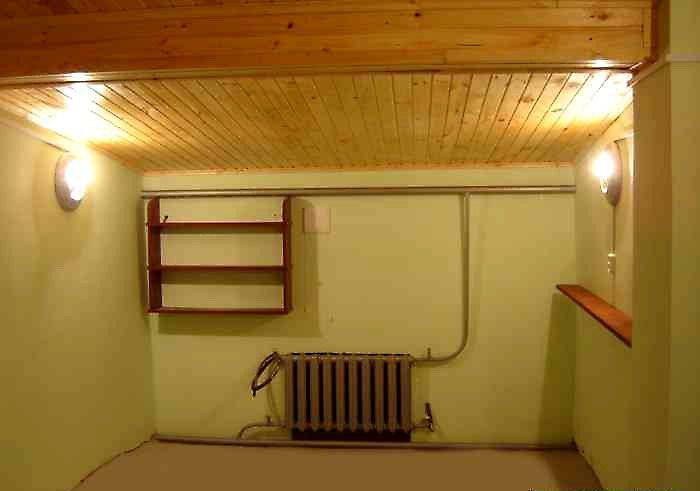
Most often, the heating is turned on during repair work, and turned off during storage of the car.
Security
One of the main requirements for garage heating is its safety. The room contains a large amount of fuels and lubricants, as well as flammable objects.

In cooperatives where structures are located end-to-end, a fire in a separate area can lead to the burnout of a significant mass. For this reason, all heating systems must have an emergency blocking facility in the event of an emergency.
Expediency
For property owners, the economic feasibility of the methods used is important. If the installed heating system requires significant operating costs, you should think about choosing another method.
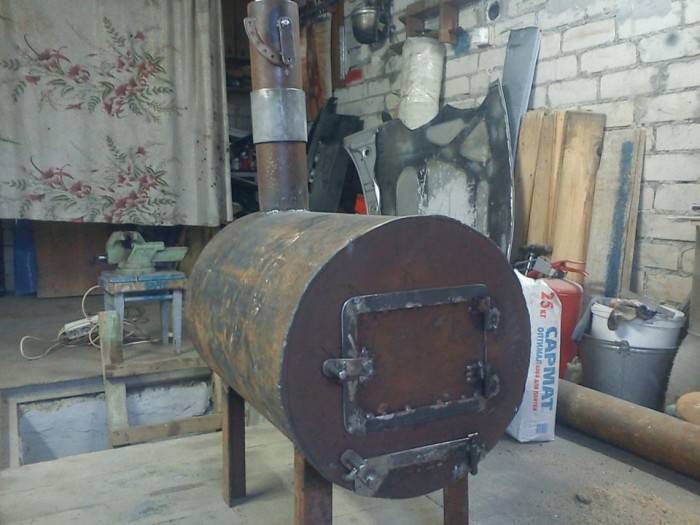
Proper garage heating must be reliable and resistant to temperature extremes outside the room. This also applies to interruptions in the supply of energy carriers.
The garage heating scheme implies preliminary thermal insulation of the room. Heating unprotected buildings is pointless - the heated air will escape through the cracks in the enclosing structures.
If warming measures are not taken, no matter how high-quality the system is, it will not heat the garage, but the space around it.
Solid fuel garage heating
Economical heating of the garage in winter is easiest to organize using solid fuel equipment. Firewood is quite cheap, it is very easy, simple and relatively safe to use it. And for their combustion, you can build a stove of any type.
If you need to organize home-made heating in the garage as cheaply and quickly as possible, it is best to turn your attention to a stove like a potbelly stove.
The potbelly stove is the simplest heating unit. Structurally, it consists of two parts - a combustion chamber and a chimney
The ash pan door and loading door are located in front. A chimney is diverted from the rear. You can create a stove stove for organizing heating in the garage from a variety of materials:
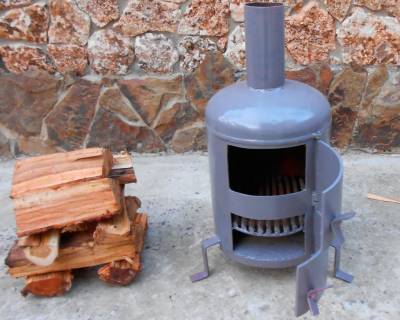
A simple stove-stove is usually the most frequently used unit for heating a garage, due to its unpretentiousness and cheap fuel.
- From an old gas cylinder;
- From a steel can;
- From an old barrel;
- Sheet metal.
There are dozens and even hundreds of drawing options, so there will be no problems with the assembly.
To organize heating of large garages, the following scheme should be used - this is a stove and batteries. In this case, in a small fire-tube heat exchanger is built into the stove, from which pipes go to home-made or purchased batteries.
The most economical way to organize autonomous heating in the garage is to use a Buleryan solid fuel stove. This oven is a convection oven, it is characterized by a very high performance and can be used to heat any technical room. Buleryan can be purchased ready-made or assemble it yourself. When creating garage heating with your own hands, remember that Buleryans are pyrolysis - this provides maximum heat transfer and long burning.
It is not difficult to make heating in the garage with your own hands - it is enough to have at your disposal the appropriate equipment or tools for its manufacture. For example, we can assemble a fireplace stove in the garage. Having found the blueprints, nothing will prevent you from making a homemade Buleryan or mounting fireplace stove with water circuit - this option is useful when creating heating in large rooms.
If you want to heat the garage as economically as possible, use ready-made factory equipment - solid fuel boilers, including those of the pyrolysis type, will be waiting for you here. In addition to them, it will remain to lay pipes and install batteries, for example, heating registers made of large diameter pipes. Factory equipment for heating systems has a higher efficiency, which will affect the economy.
It is best to build a heating system in the garage in the summer or spring, when the weather is warm outside.
Peculiarities
It is necessary to select a heating system that will ensure blocking of operation in the event of malfunctions and failures. Therefore, when creating cheap heating, it is worth considering whether this will lead to serious problems. The most convenient thing is to choose an economical option that can provide the required temperature conditions with minimal energy consumption.
Garage heating must meet the following functions:
- reliability;
- resistance to temperature extremes;
- autonomy, which will allow heating to continue in the absence of energy.
The creation of an economical garage heating system will become possible with a competent approach to the insulation of walls, roofs, garage doors, as well as with a well-thought-out ventilation system. Sometimes a competent arrangement of garage insulation is enough to service a car and start its engine without problems. If heating is still required in the garage, you must first decide on a project option.
Before creating it, it is worth considering what types of fuels are possible for use in a particular system.
The following can be considered as fuel for the garage heating system:
- solid species (firewood, sawdust, coal);
- liquid types (fuel oil, diesel, water);
- gas;
- electricity.


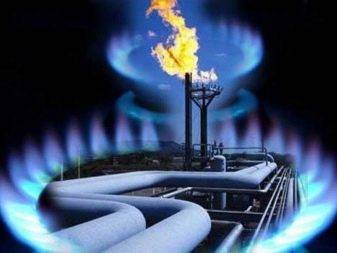

All types of fuel have some peculiarities, imply the use of this or that equipment. Depending on the type chosen, it will be possible to create one or another heating system.
For example, you can install garage heating cheaply and quickly if you choose equipment that runs on wood or other solid fuels. This type of equipment is not recommended to be installed near combustible materials, which are abundant in the garage. Therefore, wood or coal stoves for a garage cannot be called a fire-safe heating option.
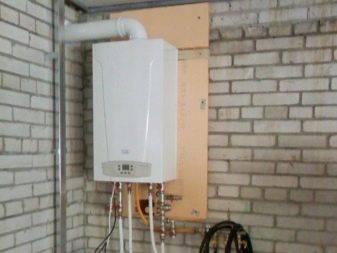
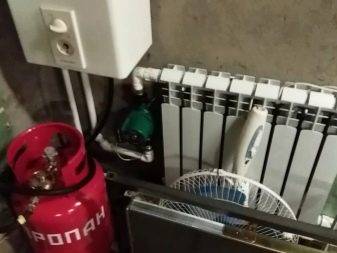
Another option that has its own characteristics is heating with electricity.
The main advantages of the equipment:
- reliability;
- small dimensions;
- no need for a chimney.
The mass of options for each type of equipment makes you think about the choice. Let's consider them in more detail.

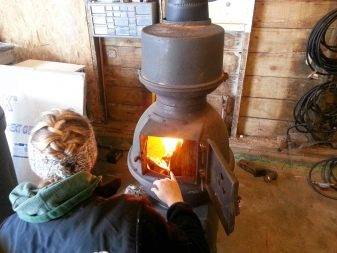
Fire safety
Of course, it is no secret to anyone that, in addition to fulfilling their main function of storing and saving a car, garage premises often serve as storage facilities for various household equipment, spare parts, old household appliances and other things that did not find a place in the apartment. And this, in fact, is not a good point, because any deposits and piles can serve as an obstacle when extinguishing a fire, as well as a good combustible material for fire.

There are certain rules that should be followed to ensure the fire safety of garage premises. They will be discussed below.
- Don't turn your garage into a storage facility for unnecessary things. It is necessary to be able to calmly move around the garage, without overcoming obstacles and the danger of tripping over any thing. The distance from the wall to the vehicle must be at least 60 cm on each side.
- If flammable liquid or oil leaks, sand it up.
- Do not refuel your car in the garage. In this case, the car must be outside the building.
- You should stock up on a fire extinguisher and a box of sand. You also need to keep several canisters of water in the garage.
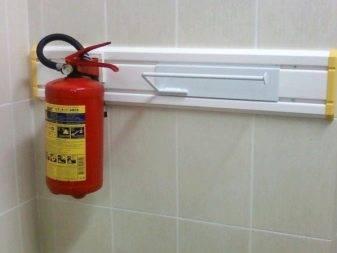

- Do not leave a car indoors with an open gas tank, or if there is a fuel or oil leak.
- There is no need to store gasoline or diesel fuel over 20 liters and engine oil over 5 liters in such a room. The same applies to empty containers from under them.
- It is forbidden to carry out paintwork in the room, wash parts with gasoline, kerosene or acetone.
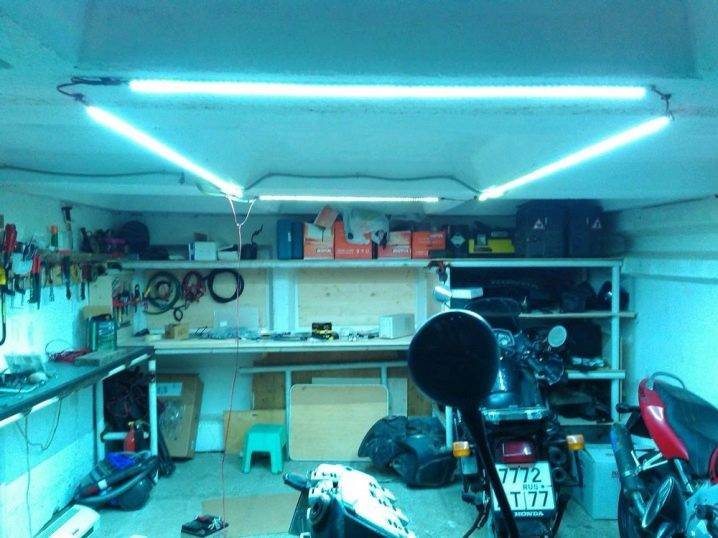
Is it possible to call heating on diesel fuel and working out economical
If you receive them completely free of charge, then you can heat a room of any format, including a garage, simply and without investing large funds. This economical heating will best achieve the required temperature in the shortest possible time and will be able to heat the room for a long time.
 It is extremely rare to use diesel fuel to heat the garage, since it is not entirely practical.
It is extremely rare to use diesel fuel to heat the garage, since it is not entirely practical.
It is not uncommon for people to have access to materials such as:
- Diesel fuel;
- Diesel fuel;
- Working off.
In order to use such fuel, you can use your own units, but only in that case, if they have a supply for the removal of combustion products outside. The structure must be connected in accordance with fire safety requirements to reduce the likelihood of fire to a minimum.
It is advisable, in order to maintain safety, to use exactly those boilers that are already ready for operation and only require connection, since they meet all the necessary standards and the moment that the heater will cause a fire or more serious consequences is excluded.
The design for heating must necessarily have a special container for oil, which can be made from a gas cylinder or other similar products. The length of the flue gas outlet into the chimney must be at least 1 m and have a diameter of 15 cm. It is best to install the chimneys straight in order to increase the level of heat transfer. The oil is poured into the tank by 3/4, and the ignition is carried out by means of a blower. As a rule, the oil does not completely burn out and smoke does not occur. The oil must be absolutely free of impurities and water. This heating can be water and, such heaters operate on antifreeze.
The best heating boilers
When the issue with the choice of energy carrier is resolved, it is necessary to decide on the type of heating boiler. It should be economical, easy to operate, and have high efficiency. Depending on the heat source, you can choose:
- Gas. The ideal option is a condensing boiler equipped with automatic control systems. In addition to the fuel cost itself, you can also save money due to the boiler's ability to operate at low pressure. In the heat exchanger of the unit, the transition of water from steam to a liquid state occurs, which leads to the release of heat. Thanks to this principle of operation, the boiler is 15% more economical than other types of gas models. You can also install a wall-mounted gas boiler, which provides for power modulation.
- Solid fuel. It is best to buy pyrolysis. The principle of operation of the unit is based on the effect of high temperatures on wood, as a result of which it decomposes into pyrolysis gas and dry residue. Gas is burnt. The boiler needs a buffer tank to operate, it accumulates heat. Of all solid-fuel models, pyrolysis is the most economical, but there is a nuance: in the absence of wood, coal cannot be used for heating.
- Electrical. If you need to efficiently heat the room and prevent overloads in the electrical network, it is better to choose a boiler with six tendencies and thyristor control. Thanks to the features of the device, you can limit the power and save money, an additional plus is silent operation. There is only one drawback, but a significant one: heating with electricity is always costly, because electricity is the most expensive source of heat.
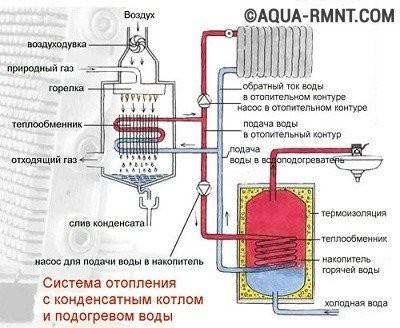
The cheapest heating for a garage is a gas condensing boiler, other types of units may be more affordable, convenient, but all of them are more expensive to operate
Fire safety requirements for the garage heating system
Before starting the installation of heating equipment, you will have to draw up a detailed diagram - this will allow you to identify vulnerable areas, including:
- wooden surfaces next to which the equipment will be located. They are covered with galvanized sheet metal;
- the place where the chimney pipe passes through a hole in the ceiling or wall;
- places of storage of fuels and lubricants. Flammable substances should be placed as far away from the heater as possible and always above the level of the floor covering.
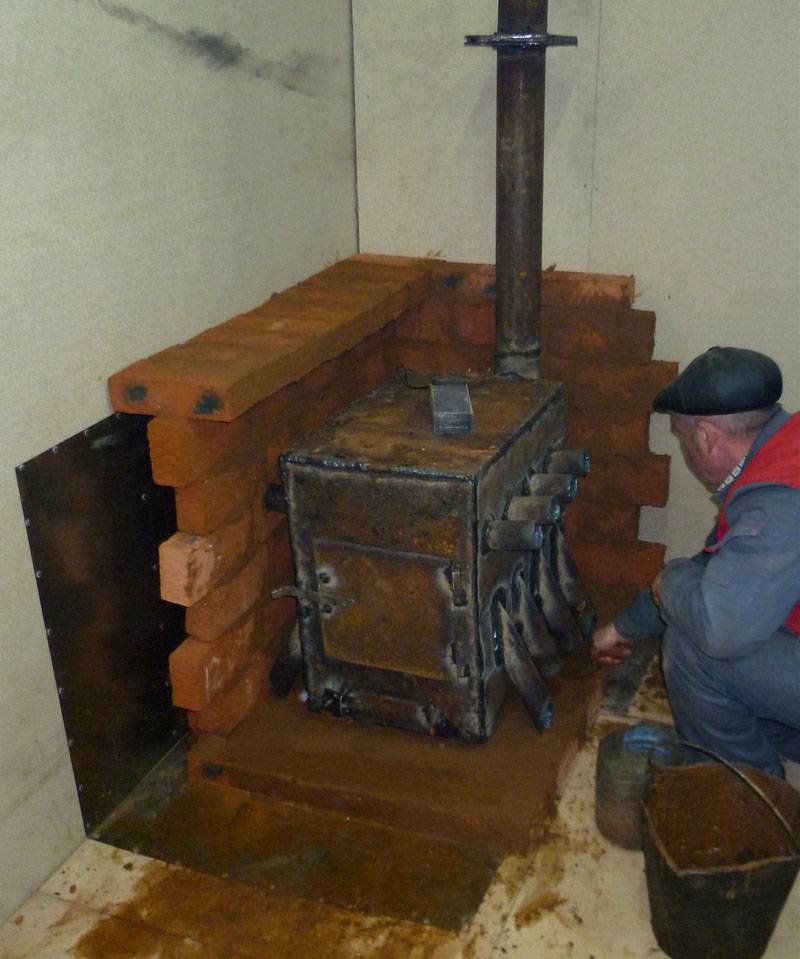 The main thing is to ensure safety
The main thing is to ensure safety
The places of the future location of fire extinguishers and other fire protection means are necessarily marked. If the system is planned with the use of combustible fuel, it will be useful to place a box with an asbestos cloth near the boiler - it will help localize the fire in the event of an emergency.
 But in such a box and without heating there are plenty of problems
But in such a box and without heating there are plenty of problems
Do-it-yourself economical water heating of the garage
First step. Install the boiler. This unit is the "heart" of the hot water heating system. The efficiency of the entire system directly depends on the correctness of its installation. Recommendations for equipment installation are given in the manufacturer's instructions. Read the instructions before starting work, because for different models of boilers, installation may have significant differences.
Second phase. Install radiators. To do this, fix the wall plugs and hang the batteries on them. You don't need special knowledge for this. The main thing is that the radiator is at a distance of at least 150 mm from the floor surface.
Stage three. Connect the individual pipes into a single pipeline. It is best to use reinforced-plastic pipes. To fasten such products, special fitting connections are used.
Stage four. Connect pipes, boiler and piping into a single heating system. In the same manufacturer's instructions, diagrams are given in accordance with which it is recommended to connect a specific boiler. It is highly recommended to read the instructions before starting work, as connecting some models of heating boilers has its own important nuances and features.
Types of garage heating
The main thing before starting to study the range of offers from various manufacturers is to correctly determine how best to heat the garage, depending on the location of the building:
- Autonomous heating for the garage is the best option if the building is located far from a residential building. Disadvantage: to equip the structure, you will need to develop an individual system, taking into account the number of cars and the size of the room.
- A common system with a residential building is ideal if the garage is located no more than 20 meters from the home or is an integral part of the main building.
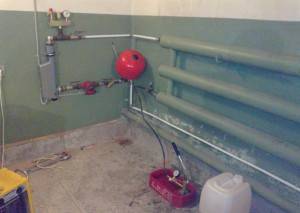 Autonomous heating for the garage
Autonomous heating for the garage
The next parameter by which all garage heating options are classified into types is the principle of operation of heat generators (sources) that convert any received energy into heat:
- Gas is a heat source with well-known advantages: low cost, high efficiency. However, such an individual garage heating system will require the involvement and remuneration of specialists at the design stage and excludes the use of self-made devices (only factory equipment). In addition, so that the costs of arranging the garage do not become a disaster for the family budget, it is necessary to build a garage in a place where there is access to a centralized gas supply line. The "disadvantages" of gas, in addition to the tangible costs of the cost of equipment and services of specialists, is the property - explosiveness. Therefore, this type of heating is not recommended for a garage.
- The water heating system is durable and reliable, and you can also install it yourself. An additional advantage is the re-suitability and simple replacement of heating radiators with your own hands: shut off the radiator, remove the faulty battery and install a new one. This type of heating is a universal solution for a garage and can be used with both general and individual heating systems. However, for a detached building, such autonomous heating of the garage will require significant costs and efforts for digging trenches, laying and insulating pipelines, installing an additional pump for pumping water (from the boiler to the building). Therefore, this type of heating is recommended if the garage is located no further than 50 meters from the main building. An alternative option is to install an automated boiler room, which will reduce the risk of winter malfunctions, but will significantly increase the budget.
- Air heating using space heaters is the most popular way to heat a garage. The advantages and disadvantages of this type of heating largely depend on the selected heat source (electricity, fuel), the power of the device, although the common disadvantages are the risk of sudden breakdown, significant operating costs (heating cost) and the dependence of the comfort level in the room on the supply of electricity.
- Heating a garage with wood, coal and other types of solid fuels is an inexpensive option for arranging a motorhome, independent of a centralized energy source. However, this type is recommended to be used only in the presence of technical problems (lack / interruptions in electricity, water, lack of a gas pipeline), since it will be necessary to exclude the storage of explosive substances, which is almost impossible for a garage. Additional "disadvantages" of the economical heating option are the need for systematic cleaning of the boiler and control over the operation of the equipment ("potbelly stoves").
- Heating a garage by working off using a special recycling apparatus is a simple and inexpensive form of heating. Waste engine oil is used as an energy source, which is purified in a special heating plant. The device can be assembled with your own hands according to a simple scheme. However, although heating with waste oil with your own hands is easy to do, experts recommend using this arrangement option only for those who are ready for frequent repairs of equipment that quickly breaks down due to the impossibility of providing the same fuel composition.
Therefore, the type of heating is the personal choice of each car enthusiast. The main parameters for choosing a system are efficiency, practicality, availability of self-assembly, optimal cost. In addition, before you make the heating yourself, you need to study the entire range of additional devices and choose the one that corresponds to individual preferences in quality, cost and is not associated with significant costs during operation.
Gas heating of the garage
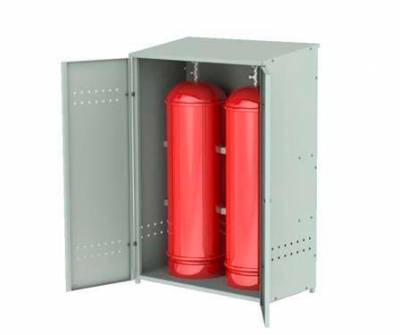
According to all safety regulations, the gas cylinder should be located outside the heated room, ideally in a closed metal box.
Heating a garage without electricity and a stove is more than realistic if you use a gas convector for this. This appliance is a completely self-contained heater that generates heat by direct combustion of gas. The resulting heat energy is dissipated with the help of a convector, organizing powerful heating. Combustion products are discharged behind the nearest wall using a two-layer chimney. The air intake required for the burner operation is carried out in the same way.
Heating the garage with a gas convector gives excellent results, because convection allows you to warm up the premises throughout the volume, passing the air in it through itself. The only drawback of such heating is the limited ceiling height, it should not exceed 3 meters. Otherwise, more efficient equipment should be used.
The gas burner in the convectors is powered by liquefied gas from connected cylinders. Consumption is 0.5-2 kg / hour, depending on the capacity of the equipment.
Garage heating can be arranged with gas infrared heaters. They will help keep your garage warm in almost any ambient temperature. But classic models need good ventilation, since combustion products are released directly into the air. The exception is catalytic heaters, which are able to heat rooms using the heat generated by the chemical decomposition of fuel. Such heating is useful not only in winter, but also in spring, when cold snaps and frosts are possible.
If the room is used on an ongoing basis, from morning to evening, heating the garage with gas from cylinders can be overhead - high gas consumption affects.
Installation work
For water heating in the garage, you will need a set of devices and parts, including:
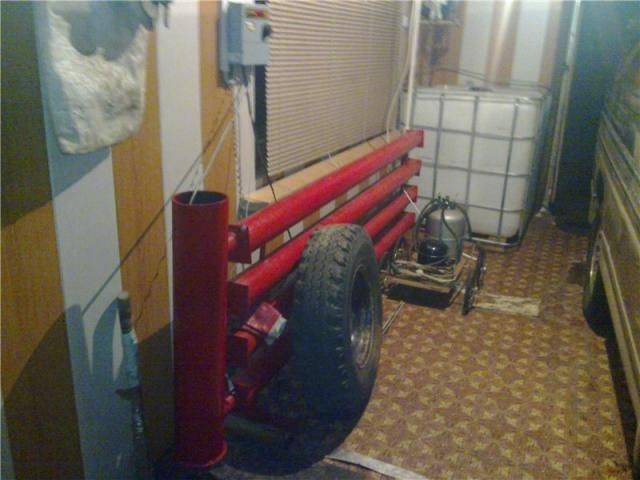
- heating boiler;
- metal radiators with good thermal conductivity;
- connecting pipes made of metal or plastic;
- fittings for fastening;
- locksmith tools.
Project development
Before starting the installation of the heating system, you need to determine the diameter of the pipes that will connect the radiators. Risers with a large cross-section will increase the flow of hot water to the radiators, increasing the efficiency of the structure.
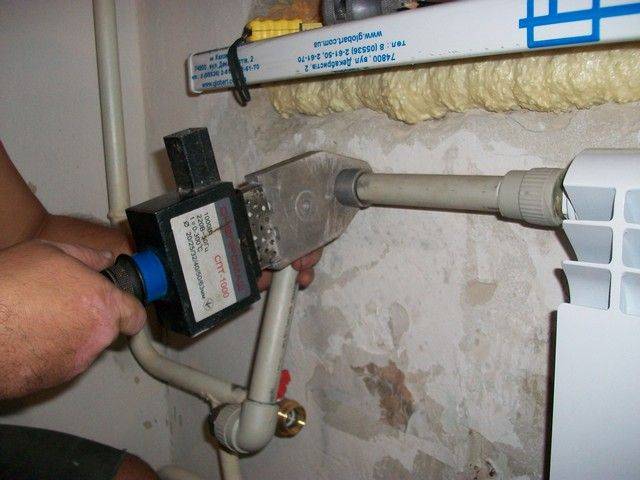
It is worth considering that heating large volumes of liquid will lead to an increase in electricity costs. The optimal layout is a balance between room temperature and heating costs. These parameters are also affected by the number of radiators in the insulated garage.
Expansion tank
The design of the garage heating system involves the use of expansion tanks. These items are made from simple plastic containers or large canisters with fill holes cut out at the top.
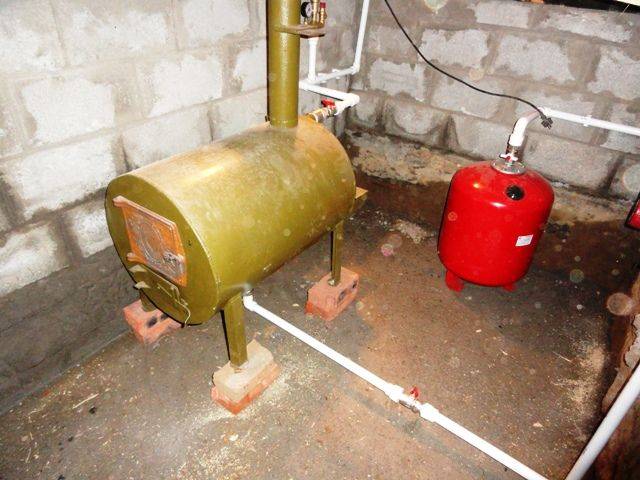
The water circulating in the system constantly evaporates and requires regular liquid addition, and the steam generated during boiling needs to be removed. The installation of the tank is carried out at the lowest point of the heating system and at a half-meter distance from the floor.
Before installing the boiler with your own hands, you will need to prepare a metal pipe of a certain diameter with a half-meter or one-meter length. Its extreme end is tightly welded with a metal sheet.

The next step will be to assemble the flanges for fixing the tubular electric heaters and fix them on the boiler using bolts. To supply the working fluid to the installation, two pipe sections are welded with the diameter that will be used in the heating system.
Heating radiators are attached to garage walls using special reinforced dowels. The distance from the floor to the radiator must be at least fifteen centimeters. For effective heating, a few centimeters of free space must be left between the walls and the heating elements for air circulation.

Individual structural elements are connected to the system using metal or plastic pipes with special fittings. The seams of their joints and forks require special attention during installation, so that in the future during operation there will be no leaks.
The connection of metal pipes is carried out using a welding machine. Working with polypropylene will require the use of a special soldering iron. Regardless of the material of the pipes, they must be placed on the walls with a slope - this will improve the circulation of the liquid.
The water heating system is considered ready after connecting the radiators to the risers and connecting them to the boiler using a rubber hose.Before starting operation, it is recommended to re-inspect the line, search for defects and seal problem areas.
6 Gas heaters

the cheapest type of heating
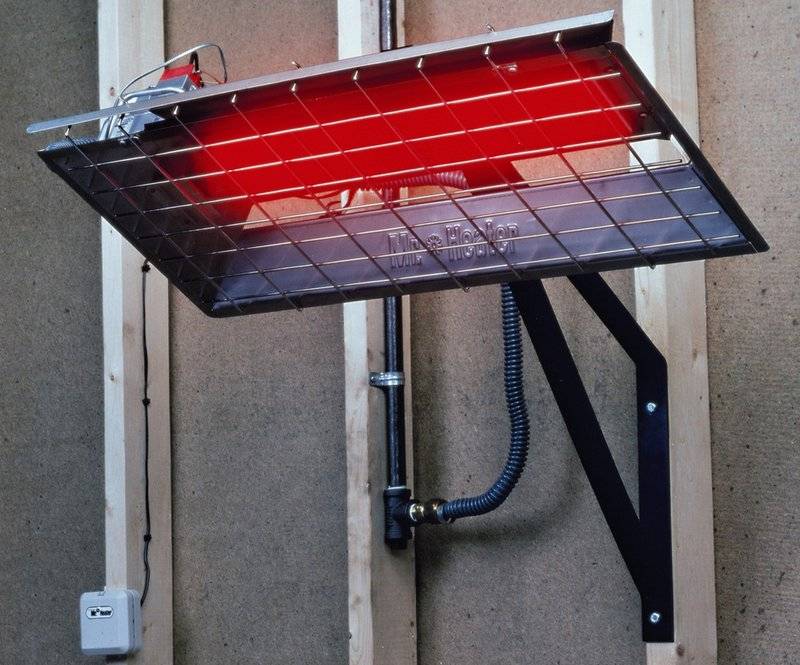
In the ceramic honeycomb of infrared gas heaters, gas is burned, thanks to which warm air enters the room. In order to independently heat the garage in the winter, the owners connect to the gas mains after completing the necessary documentation and making an advance payment for the tie-in into the main gas pipeline.
The use of gas is the most difficult version: the need to design and then mount a heating system, buy and install a boiler. The costs will be justified only if the spacious garage space is constantly heated in winter. The rest of the options are easy to operate, so they do not require special permits. Bottled gas can be used for their implementation. In this case, gas cylinders should be kept in closed metal boxes at a sufficient distance from the heating elements.
Electric garage heating
The easiest way is to heat the garage with electricity by adapting a suitable heater, purchased or homemade, for this. If there is no money to buy factory equipment, you can make it yourself. The simplest heating device is a goat heater, the most affordable, but also the least efficient. It is done easily and simply - some kind of non-combustible dielectric is taken, a wire of nichrome is wound around it. Next, we connect an electrical cable to the product and plug it into an outlet.
Among all the options for heating a garage, this option is considered the most dangerous - with electricity in general, jokes are bad. Bare nichrome wire is used here, there is no insulation. Users could be burned or electrocuted and there is a risk of fire. It is forbidden to leave such heating unattended. And in general - you should not use such artisanal and extremely dangerous heaters.
Electric heating of the garage can be organized with factory heaters:

Before you start choosing the type of heating, it is worthwhile to attend to at least the minimum thermal insulation of the garage. Otherwise, the heat will simply go out into the street.
- Heat guns - they are extremely safe and provide fast heat injection into the garage. It takes a few minutes to warm up the entire volume, after which it will become warm in the room. Minus - increased noise level;
- Infrared heaters are a modern solution with high efficiency. Infrared heating of the garage does not dry the air and does not harm your health. Simple IR heaters are used here, which do not heat the air itself, but the surrounding objects, as a result of which they begin to emit heat;
- Electric convectors are a great way to heat up a garage in winter and not have to worry about installing or manufacturing complex equipment;
- Electric boilers - in this case, a classic water heating using an electric boiler is organized in the garage. A boiler for a garage is selected in accordance with its area and heat losses, focusing on the formula of 1 kW of heat per 10 sq. m. area.
Heating the garage can also be organized with the help of a home-made boiler - for this you need an electric heating element of suitable power, which must be built into a metal pipe of one diameter or another. Further, bends are welded to the pipe, to which a water heating system with batteries is connected. By the way, the same batteries (heating registers) can be made independently using pipes with a diameter of 100 mm.
The main disadvantage of any electric garage heating is its high cost - electricity is quite expensive, which leads to high costs. The most economical way to heat with electricity is with infrared heaters.
1 Heating methods
The most popular and economical way is electric heating of garage premises.Moreover, this method is suitable when the garage is located at a certain distance from the residential building and is small in size.
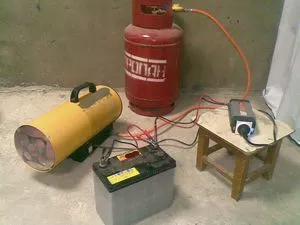
The electric convector is a safe and highly efficient electrical appliance
This design, of course, is very convenient, because it makes it possible to place the heater both on the wall and near the car during its repair. Despite some disadvantages that are present in convectors, for example, the effect is achieved 30 minutes after connecting it, the consumption of electrical energy increases, the high price, nevertheless, electric convectors also have a lot of advantages:
- heat rooms automatically and manually;
- safe and easy work;
- durable;
- work in humid and dusty rooms, as they are protected by the case.
Heating the garage with electricity: the most convenient and economical way
Electric heating is a system that has a fairly high efficiency, but it has its own disadvantages and this is too high a cost. If you heat the garage all day and almost daily, then the cost of electricity will be far from small.
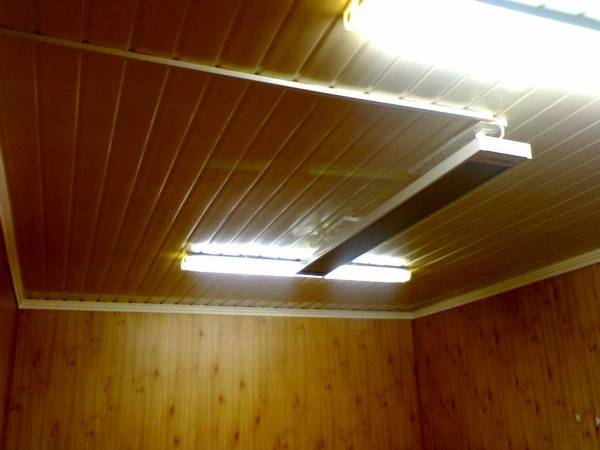 Heating the garage with electricity is popular and in demand today.
Heating the garage with electricity is popular and in demand today.
The way to heat a garage with electricity is:
- Comfortable;
- Practical;
- Available.
In addition, the electric boiler is not autonomous, since it directly depends on the supply of electricity, and when it is turned off, it will not work. Among the minuses, it can be noted that not every person can connect electric boilers, and you will need to contact specialists for an additional fee.
Heating with electricity can be carried out using a portable heater, for example, it can be a heat gun or a stationary
It is important that the equipment is installed as correctly as possible, since a stationary one requires a special niche and a protective screen, and it is strictly forbidden to store oils and fuel for a vehicle next to it. Heating a room with an electric heating element is a stationary method, with great efficiency and too high energy consumption, and therefore, before giving preference to this option, you need to look through all the positive and negative sides
Gas heating for garages
Gas pipelines are not everywhere, but if there is such a possibility, then there is no alternative to this fuel in terms of cost and efficiency. In some cases, it is possible to use imported gas in cylinders.
Boiler types
Gas heating systems for the garage are of 3 types:
- gas boilers with a burner in the furnace and a heat exchanger for a liquid heat carrier;
- gas convectors that directly use the energy of fuel combustion in a special chamber;

Photo 2. Infrared gas floor heater, installed away from flammable liquids.
infrared gas installations.
Important! It is impossible to independently manufacture equipment for such heating. All units and parts must be of factory origin and be certified
The device of a convection gas boiler consists of a combustion chamber with a built-in convector and a special double chimney that removes combustion products into the chimney. Due to the air intake system, oxygen is supplied to the combustion site and heat energy is spread throughout the room.
Modern gas installations have a thermostat and automatic temperature control. With its help, fuel consumption is reduced to 0.5-1 liters per hour. Ceiling height limitation - 3 meters. At higher altitudes, the air masses will mix worse.
Install the boiler away from flammable liquids and materials. Placement can be wall or floor.A gas cylinder is located outside the garage in a special cabinet, and a shut-off valve must be installed on the main gas pipeline.
Advantages and disadvantages
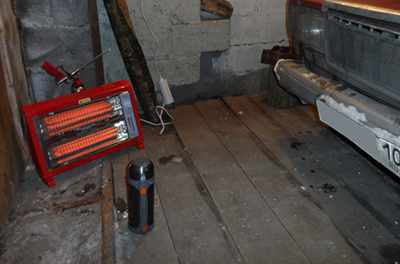
Benefits of heating gas:
- high efficiency;
- low cost;
- compactness of the entire installation;
- great heat dissipation immediately after switching on;
- factory boiler safety;
- ease of use and portability.
Disadvantages of gas heaters:
the need to observe increased precautions;
in open installations, combustion products enter the ambient air;
difficulties with constant filling of cylinders; some models require electricity
How to choose the optimal heat source?
First of all, you need to choose the most optimal variant of the heating system. In this moment, everything is individual and depends on the characteristics of a particular situation.
If the garage is connected to the house or is no more than 20 m away from it, it is best to connect the garage to the communal heating system.
The best option for organizing heating is connecting the garage to the general heating system
If the garage is located far from the main building or is even part of a cooperative, the only available option is to organize an autonomous heating system. When calculating the heating power, you need to take into account the area of the garage and the number of cars that are stored in the room.
The next important point is choosing a suitable heat source. Devices that use gas, electricity, solid fuel and mining are suitable for heating the garage.
Gas
Gas, other things being equal, is the most affordable fuel. However, the costs of arranging a gas heating system are very high. Firstly, you can use only high-quality factory-made equipment. Secondly, for the device of such heating, it is necessary to involve specialized specialists.
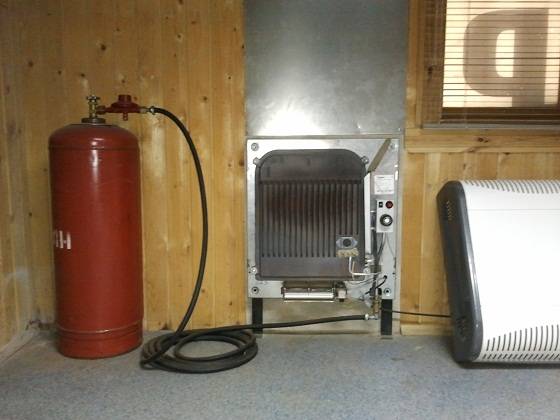
Gas convector
Self-assembly of gas units is unsafe. The slightest mistakes during the installation process can lead to deadly situations in the future. gas is flammable and explosive by its properties.
Electricity
The most convenient and popular option for heating garage premises is an electric heating device. You can install a stationary electric boiler or assemble the system yourself from mobile installations.
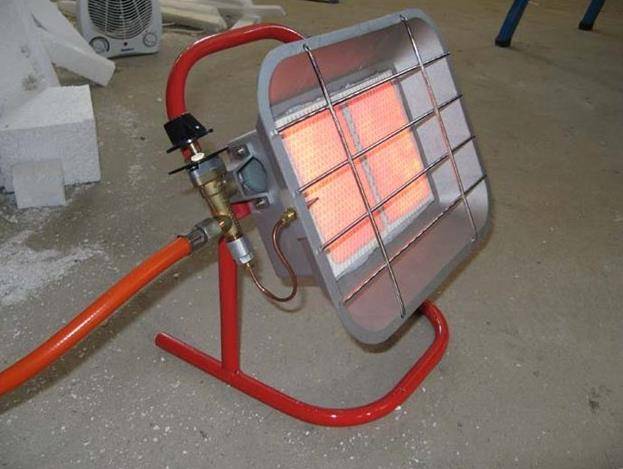
Electric heater for garage
A huge range of electric heaters is available on the modern market, so you will not have any problems with choosing equipment of the required power and suitable cost.
An additional advantage of electric heating is the extremely simple installation and setup. In most cases, it is enough to simply install the units in convenient places and connect them to the power grid.
Solid fuel
Quite often, garage heating is organized using solid fuel plants using coal, wood, peat, etc. for work. Solid fuel heating is mainly used where difficulties arise with the device of other heating systems. For example, in areas without central gas supply and with problematic power grids.
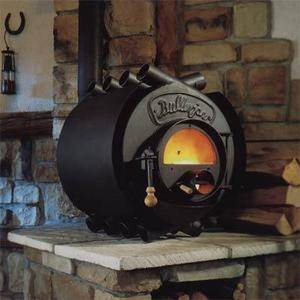
Solid fuel heating
An elementary potbelly stove for heating a garage can be welded with your own hands from an old pipe or barrel, which makes solid fuel heating even more cost-effective.
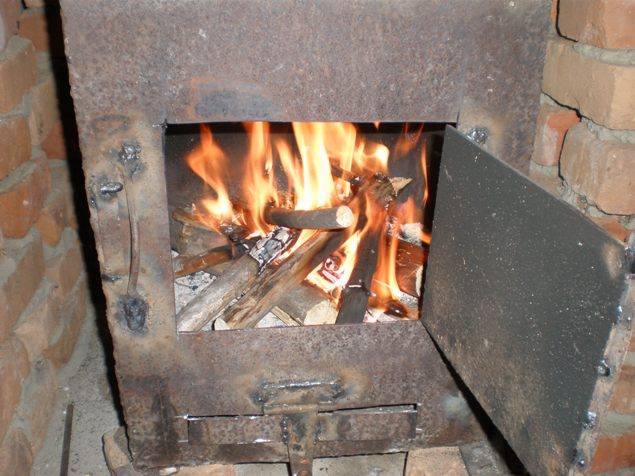
Potbelly stove
Butter
And the last popular option for heating a garage is heating with waste engine oil. The system requires the purchase or self-assembly of a special heating unit for oil purification and processing. The method is cheap, but extremely inconvenient.First, you need to constantly take oil somewhere. Secondly, self-made units for fuel processing fail very quickly.
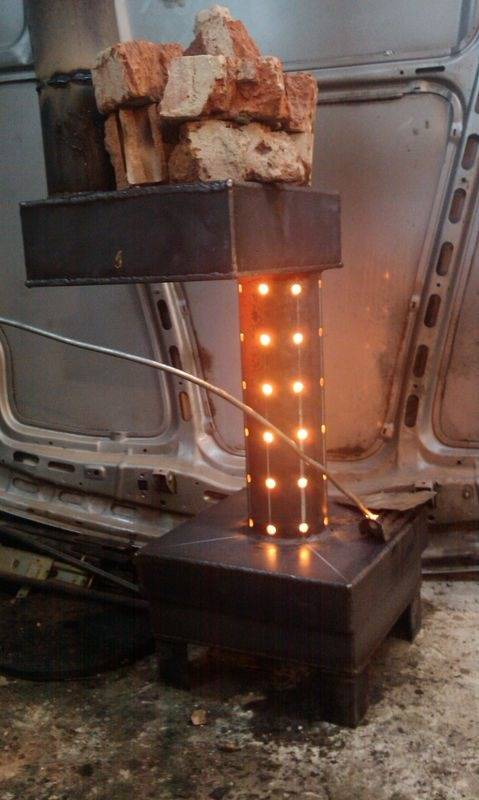
Working furnace
Thus, the most profitable heat source is gas. However, quite serious money will have to be spent on the purchase and installation of gas heating. And in the absence of the possibility of connecting to the centralized gas supply, it is better to refrain from the device of such heating.
Electric garage heating is easy to install and convenient to use. However, electric heating requires competent design and a number of preparatory calculations.
It is important to determine as accurately as possible the required power of the units so that energy is not wasted, because electricity is hardly a cheap resource
